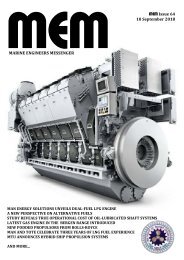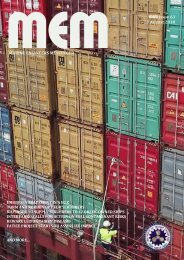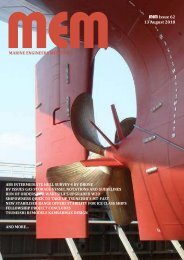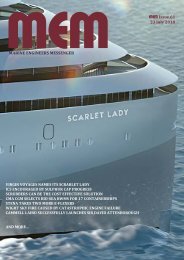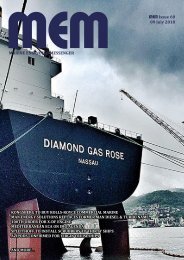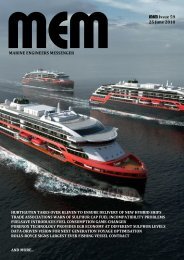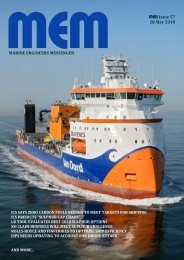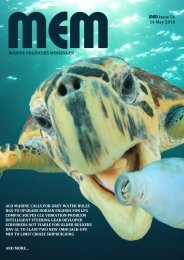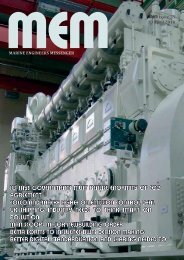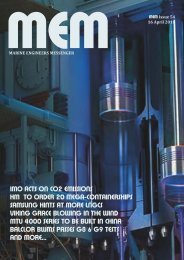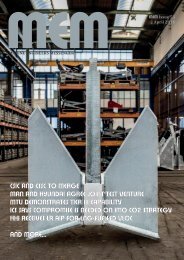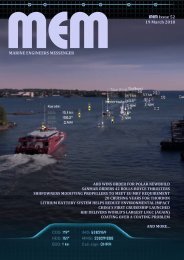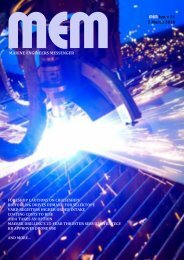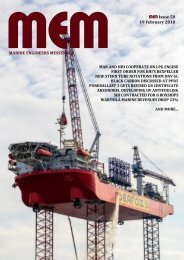Create successful ePaper yourself
Turn your PDF publications into a flip-book with our unique Google optimized e-Paper software.
MEM<br />
MEM<br />
MARINE ENGINEERS MESSENGER<br />
Issue 36<br />
24 July 2017<br />
HULL BIOFOULING RESEARCH CALLS FOR ACTION<br />
POTENTIAL FOR LNG FUEL ACROSS THE IBERIA<br />
ICS PLEASED WITH IMO PROGRESS ON ENVIRONMENT<br />
BEWARE THE BIOFUEL<br />
BOURBON TO DEVELOP THE AUTONOMOUS OSV<br />
RAY OF SUNSHINE FOR GERMAN OEMS
MEM<br />
MARINE ENGINEERS MESSENGER<br />
MEM Issue 36<br />
24 July 2017<br />
Telegraph<br />
MAN Diesel & Turbo is a key supplier to a project underway<br />
to demonstrate the feasibility of fusion as a future energy<br />
source. MAN Diesel & Turbo’s fabrication specialists in<br />
Deggendorf is contributing to the ITER project, by fabricating<br />
“port stubs, fabricated for the Italian company Walter Tosto,<br />
which will the stubs in ITER’s vacuum vessel. This will house the<br />
fusion reactions and act as a first safety containment barrier.<br />
“We are helping to bring the source of the sun’s energy<br />
down to earth,” says Dr. Uwe Lauber, CEO of MAN Diesel &<br />
Turbo. “Our experts participating in the construction of a fusion<br />
reactor which may soon demonstrate power can be generated in<br />
the same way the sun does it.”<br />
The ITER project is funded and run by seven member entities:<br />
Japan, the European Union, the United States, Russia, China, South<br />
Korea and India. In southern France, 35 nations are collaborating to<br />
build the world's largest tokamak – a magnetic fusion device designed to prove the feasibility of fusion as a<br />
large-scale and carbon-free source of energy based on the same principle that powers our sun and stars.<br />
The first ITER order to MAN was booked in 2012. It encompassed the delivery of 18 so-called Upper<br />
Ports to Russian JSC NIIEFA, the Efremov Institute of Electrophysical Apparatus. More than 1000t of<br />
stainless steel is currently being processed by MAN in Deggendorf in order to deliver the Upper Ports<br />
starting this summer.<br />
MAN received the second ITER order from Indian multinational conglomerate Larsen & Toubro, which<br />
is manufacturing the critical Cryostat at Hazira, India. This order comprises the assembly of the Cryostat.<br />
The largest stainless steel high-vacuum chamber ever built (16,000m³), which provides a high vacuum,<br />
ultra-cool environment for the vacuum vessel and the superconducting magnets. With this order, MAN was<br />
one of the first companies on the construction site in France, when works started in mid-2016.<br />
Please note, the next edition of MEM will be published on the 21 August<br />
MARINE ENGINEERS MESSENGER<br />
SHIP TECHNOLOGY NEWS TO 8544 DECISION MAKERS<br />
EVERY TWO WEEKS<br />
Click here for more information about our favourable advertising rates or<br />
email: mem@seabornecomms.com<br />
3
LNG<br />
POTENTIAL FOR LNG FUEL ACROSS THE IBERIAN PENINSULA<br />
With the global fuel sulphur limit of 0.5% entering into force in 2020, the<br />
interest towards LNG as a marine fuel is increasing. However, one of the main<br />
obstacles to the accelerated uptake of LNG is the uncertainty regarding future<br />
market volumes for LNG. DNV GL has addressed this issue in a recent market<br />
study on the future LNG market in the Iberian Peninsula.<br />
DNV GL conducted the study on behalf of the six-year CORE LNG as Hive<br />
Project 1, which aims to provide an investment plan for LNG fuelling in Spain<br />
and Portugal. The €33M project is coordinated by Enagas, and co-funded by the<br />
European Commission.<br />
The study forecasted the potential future demand for LNG as a ship fuel and<br />
the required future infrastructure for the areas around Spain and Portugal and<br />
other areas covering the Mediterranean and Atlantic. The results have<br />
contributed to the CORE LNG as Hive project’s recommendations for the<br />
development of the LNG supply chain infrastructure, involving over 40 ports in<br />
the project area.<br />
Fernando Impuesto, project coordinator from Enagas (pictured top right),<br />
said: “The consortium partners selected DNV GL to execute the demand studies<br />
of the project based on the fact that DNV GL has been at the forefront of the<br />
development of LNG as a ship fuel. Through this market study we have a strong<br />
decision basis to prepare the supply side on the Iberian Peninsula in meeting<br />
future demand for LNG bunkering at competitive conditions.”<br />
Despite LNG fuelled shipping being high on the maritime agenda, the market<br />
drivers have appeared to change, with a shift towards emissions compliance.<br />
The study revealed a huge potential for LNG as a marine fuel that will utilise<br />
the current spare capacity of the existing LNG import terminals. The<br />
consolidated quantitative results show that by 2030 up to 2Mm³pa of LNG is to<br />
be bunkered by ships and by 2050 approximately 8Mm³pa of LNG.<br />
The market study further concludes that existing LNG terminals will need to<br />
develop break bulk capacity to allow for loading LNG to small carriers and LNG<br />
bunker vessels. In most ports, development of local intermediate storage<br />
capacity needs to be synchronized with increasing LNG demand by larger<br />
vessels. Small carriers for delivering batches of LNG to ports are expected to play a key role in the future.<br />
However, to realize the predicted LNG supply chain in 2030, about €1bn of capital expenditures (CAPEX)<br />
investment will be needed, adding up to a total cost of €3.7bn in 2050.<br />
“DNV GL’s market study has clearly shown the major potential LNG has as a fuel in the region,” Liv Hovem,<br />
Senior VP, DNV GL – Oil & Gas, added (pictured). “We hope that the conclusions from our study will help<br />
shipowners, natural gas suppliers, bunker companies, port authorities and LNG terminal operators gain the<br />
confidence they need to move forward with LNG as a fuel for a more sustainable shipping industry.”<br />
BV GRANTS APPROVAL IN PRINCIPLE FOR W-FRSP<br />
Bureau Veritas has granted Approval in Principle to Wison Offshore & Marine’s newly-developed floating<br />
storage regasification and power generation barge.<br />
Dubbed the W-FSRP, the barge integrates functions of LNG loading and storage facilities, regasification and<br />
power generation.<br />
Maarten Spilker, Senior Solutions Director of Wison Offshore & Marine said: “With the interest in small scale<br />
LNG-to-power growing, we are developing the building blocks for a<br />
lean and integrated supply chain. Combining LNG storage,<br />
regasification and power generation on a single facility significantly<br />
reduces the cost of infrastructure and makes small scale gas-topower<br />
solutions more attractive.”<br />
Jiahui Wu, Technical Manager of Bureau Veritas China said:<br />
“Bureau Veritas is very pleased to be involved at the very early stage<br />
of this 50MW FSRP design and to provide necessary technical<br />
assistance to Wison in order to help shipyards develop a safe and<br />
effective power supply solution for near shore floating facilities to<br />
end users. Wison is one of the most active players in the new sectors<br />
of offshore market such as floating power plant.”<br />
4
The barge is designed to supply 50MW electrical power using LNG as primary fuel and MDO/HFO as backup.<br />
The FSRP will be of shallow draft barge type moored at a jetty, inter coastal or alongside river bank where the<br />
environmental condition is benign.<br />
The W-FSRP features an integrated onboard LNG storage, regasification facility, and power plant and can be<br />
towed/shipped and installed in remote areas. Either LNG storage or MDO storage allows about 14 days<br />
operation. However, a larger hull to accommodate more MDO storage or larger LNG tanks is available if<br />
requested.<br />
LNG CONTAINMENT<br />
GTT SYSTEM FOR MOL LNGCS<br />
GTT has received an order from the Chinese Shipyard Hudong Zhonghua Shipbuilding for its NO96-L03+<br />
containment system for installation to four 174,000m3 LNG carriers which will be built for Mitsui O.S.K. Lines<br />
Ltd. (MOL). Delivery of the first vessel is scheduled for late 2019.<br />
Philippe Berterottière, Chairman and CEO of GTT said: “We are very pleased to further strengthen our<br />
relations with our partner Hudong Zhonghua. This is an extraordinary order, a very large and major<br />
shipbuilding project to which we are proud to contribute. In addition, the four vessels concerned will be<br />
equipped with the technology NO96-L03+, a success for the new GTT technologies recently developed.”<br />
The new insulation system is an evolution of the well-known NO96 technology which equips more than 200<br />
vessels in the world. The configuration of the containment system “guarantees” a boil-off rate of 0.1% cargo<br />
volume per day.<br />
EU MRV<br />
VERIFAVIA SHIPPING EXCEEDS 1000 SHIPS UNDER EU MRV<br />
Verifavia marked a significant milestone in the company’s history with over 1000 ships and Monitoring Plans<br />
(MPs) under assessment for compliance with the European Union’s Monitoring, Reporting, and Verification (EU<br />
MRV) regulation.<br />
Verifavia Shipping will be working with several leading global shipping companies towards timely, efficient<br />
and cost-efficient EU MRV compliance. In addition, Verifavia continues to certify EU MRV solutions and systems,<br />
which seek to streamline the data collection and reporting process for shipping companies needing to comply<br />
with the EU MRV Regulation. The company currently has circa 60 shipping companies spanning 1052 ships and<br />
16 ICT providers on its client roster.<br />
5
EMISSIONS<br />
ABS UPDATES ADVISORY AHEAD OF 2020 SULPHUR CAP<br />
Classification society ABS has updated its guidelines on Exhaust Gas<br />
Scrubber Systems (Scrubber Advisory) to help industry prepare for<br />
IMO’s 2020 global sulphur cap.<br />
The updated Advisory includes background on air emission<br />
regulations and explores the diverse types of available scrubber<br />
technologies along with the associated installation and operational<br />
challenges for each.<br />
“As we close in on 2020, scrubbers are under increasing<br />
consideration as a solution for many vessels,” said ABS Director of<br />
Environmental Performance Thomas Kirk.<br />
“By utilising this Advisory to understand the unique characteristics<br />
of the available scrubber technologies, the marine industry will be able<br />
to make smarter decisions on the future of their fleets.”<br />
ABS introduced the world’s first scrubber-ready notation, providing<br />
guidance for owners who are planning to retrofit their vessel with a<br />
SOx scrubbers. By looking ahead during the design phase and<br />
accounting for possible retrofits in the future, owners are better<br />
prepared for future regulatory requirements and able retrofit their<br />
vessels more cost effectively.<br />
ABS also published the ABS Guide for Exhaust Emission Abatement<br />
which applies to vessels fitted with an exhaust emission abatement<br />
system, including SOx scrubbers, selective catalytic reduction systems and exhaust gas recirculation for nitrous<br />
oxide (NOx) emission control. ABS can provide further support by completing a techno-economic analysis of<br />
the arrangements. Such studies consider the impact of capital and operating expenses to determine the life<br />
cycle cost of the installation, providing critical information to support vessel owners and operators in the<br />
decision-making process.<br />
ICS PLEASED WITH IMO PROGRESS ON ENVIRONMENTAL ISSUES<br />
The International Chamber of Shipping (ICS) has given its support to “a good start on the development of a CO2<br />
reduction strategy”, following the outcome of the recent Marine Environment Protection Committee (MEPC<br />
71). The ICS said it is confident it will match the ambition of the Paris Agreement on climate change and that<br />
significant progress was made on the general outline of an initial strategy for adoption in 2018.<br />
ICS Director of Policy, Simon Bennett, said: “Though no detailed decisions have yet been taken by IMO, the<br />
industry’s specific proposals have been well received by a number of governments among both developed and<br />
developing nations, and there is generally willingness on all sides to give further consideration at the next IMO<br />
working group on the strategy in October.”<br />
In a submission to MEPC71 from the ICS and other shipping associations, the industry proposed that IMO<br />
should adopt a few CO2 reduction objectives on behalf of the international shipping sector, while emphasising<br />
that that delivery of truly ambitious CO2 reductions will be dependent on the development of alternative fossilfree<br />
fuels. Specifically, the industry proposed that the sector’s total CO2 emissions should not increase above<br />
2008 levels, thus establishing 2008 as the year of peak emissions from shipping, and that IMO should agree<br />
upon a percentage by which the total emissions from the sector might reduce by 2050.<br />
“Encouragingly, there seems to be a general understanding among nearly all IMO Member States that IMO<br />
needs to adopt a truly ambitious strategy if it is to remain in control of regulating CO2 from ships, so that the<br />
application of unilateral measures such as the proposed incorporation of international shipping into the EU<br />
Emissions Trading System and the resultant market distortion will be unnecessary,” said Bennett.<br />
ICS has welcomed the IMO decision to adjust the implementation dates of the IMO Ballast Water<br />
Management Convention so that existing ships, delivered before the entry into force of the Convention on 8<br />
September this year, will not be required to install treatment systems until after their first International Oil<br />
Pollution Prevention (IOPP) survey after 8 September 2019.<br />
Bennett added: “This is a victory for common sense that will allow shipping companies to identify and invest<br />
in far more robust technology to the benefit of the environment.”<br />
ICS says that existing ships will now be able to install equipment typed–approved in accordance with the<br />
more stringent standards that IMO adopted in 2016. The industry should therefore have greater confidence<br />
that the systems ships are required to install will indeed be fit for purpose in all operating conditions<br />
worldwide, which was not the case with several of the systems approved using the old IMO guidelines.<br />
6
L'ASTROLABE LAUNCHED WITH IMO TIER III<br />
EIAPP ENGINES<br />
The launch of the L'Astrolabe, a 72m polar logistics vessel<br />
fitted with a complete Wärtsilä propulsion machinery<br />
package and Wärtsilä NOR (NOx Reducer) SCR (Selective<br />
Catalytic Reduction) exhaust gas cleaning systems for all<br />
the main engines, took place this month<br />
L'Astrolabe is the first vessel operating with the<br />
International Maritime Organisation's IMO Tier III EIAPP<br />
(Engine International Air Pollution Prevention) certified<br />
Wärtsilä diesel engines.<br />
The ship was built by PIRIOU (France) for the French<br />
Southern and Antarctic Lands Administration. It will be<br />
used to transport personnel and supplies to the Dumont<br />
d'Urville research station in Antarctica.<br />
The four IMO Tier III certified eight-cylinder Wärtsilä<br />
20 diesel engines are combined with Wärtsilä NOR<br />
systems to be fully compliant with the IMO Tier III exhaust<br />
emission regulations set out in Annex VI of the MARPOL<br />
73/78 convention. The IMO Tier III EIAPP certification<br />
was carried out according to Scheme B based on the<br />
requirements of IMO Resolution MEPC.198(62). The Tier<br />
III EIAPP certificates were issued by Bureau Veritas.<br />
The full scope of supply comprises four Wärtsilä 20<br />
main engines, two Wärtsilä controllable pitch propellers<br />
and shaft lines including Wärtsilä reduction gears,<br />
Wärtsilä NOR systems, and a Wärtsilä tunnel thruster.<br />
SCR technology is currently the primary means for NOx<br />
abatement, and Wärtsilä's NOR system is available for use<br />
with all Wärtsilä medium speed engines. The system<br />
enables vessels to be compliant with global NOx emission<br />
control area regulations. Furthermore, with the Wärtsilä<br />
NOR the overall performance of the engine and exhaust<br />
gas cleaning system is optimised in terms of emissions<br />
reduction, noise abatement and engine efficiency. Wärtsilä<br />
provides IMO and EPA Tier III certificates for its engines<br />
combined with a Wärtsilä NOR system.<br />
"We have been pleased to deliver this combination of<br />
engines and SCR systems in the same scope of supply, and<br />
take full responsibility for exhaust gas emissions,<br />
performance, documentation, statutory approvals and<br />
certification. Such packages are convenient for shipyards<br />
and ship operators, and triggered by IMO regulations are<br />
expected to be specified by an increasing number of<br />
shipyards and ship owners. The engine needs to be SCR<br />
compatible, and the SCR should be fit for purpose. It has<br />
been a pleasure to work with Chantries Piriou,” says Juha<br />
Kytölä, Vice President, Environmental Solutions, Wärtsilä<br />
Marine Solutions.<br />
"For this type of vessel operating in the most<br />
challenging ice and weather conditions, the engine<br />
selection had to be carefully made. We know and respect<br />
Wärtsilä's capabilities and technical know-how, and we<br />
are confident that we have made the best possible choice<br />
for this important vessel," says Vincent Faujour, PIRIOU<br />
CEO.<br />
L'Astrolabe will have accommodation for 60 persons, a<br />
cargo capacity of 1400t, and is fitted with a helideck large<br />
enough to accommodate two helicopters.<br />
Type Approved<br />
to IMO MEPC<br />
227 (64)<br />
MARIPUR NF<br />
CLARIMAR MF<br />
ACO Marine's new MARIPUR NF and CLARIMAR MF advanced<br />
wastewater management systems are the merchant, naval and<br />
megayacht sectors most effective solutions for meeting<br />
stringent IMO MEPC 227(64)<br />
rules.<br />
Compact and economical<br />
with the lowest operating<br />
costs of any sewage<br />
treatment plant, CLARIMAR<br />
MF and MARIPUR NF are<br />
proven to reduce<br />
coliform bacteria, TSS,<br />
COD, nitrogen and<br />
phosphorous content to<br />
levels significantly below<br />
the mandated requirements.<br />
Mark Beavis - Managing Director<br />
Nádrazňi 72, CZ -15000 Praha 5,<br />
Czech Republic<br />
Tel: +420 724 011 775<br />
Email: mbeavis@acomarine.com<br />
Web: www.acomarine.com<br />
7
NEW DNV GL NOX TIER III COMPLIANCE GUIDE<br />
Classification society DNV GL has developed a new brochure to offer a set of best practices for the design of<br />
ships subject to NOx Tier III requirements. It also offers guidance on the considerations that should be<br />
considered at the newbuilding stage.<br />
To ensure the success of any newbuilding plan, shipowners should carefully consider the future operation of<br />
their vessels in the newbuilding planning stage, including the implications of the different technological<br />
solutions for reducing NOx emissions and how to fulfil the NOx Tier III requirements. In order to fulfil the<br />
stricter NOx Tier III emission limits, ship operators have the possibility of choosing from various options. The<br />
optimal compliance option will depend upon many factors, including a vessel’s individual trading pattern,<br />
engine size and speed. The brochure examines selective catalytic reduction (SCR), exhaust gas recirculation<br />
(EGR), the use of alternative fuels, internal engine modifications, direct water injection (DWI), fuel-water<br />
emulsion (FWE) and intake air humidification.<br />
Installing NOx Tier III-compliant technology can offer benefits beyond simply achieving compliance with<br />
emissions regulations. Demonstrating a company’s commitment to ensuring sustainable operations has become<br />
increasingly important. In addition, the installation of Tier III-compliant technology also goes hand in hand<br />
with direct financial benefits, as many major ports offer substantial discounts on harbour fees if a vessel<br />
complies with third party environmental schemes such as the ESI.<br />
The new brochure can be downloaded free of charge on DNV GL’s website<br />
here: https://www.dnvgl.com/maritime/publications/NOx-TIER-3-Update-download.html<br />
FUEL<br />
BEWARE THE BIOFUEL<br />
Widely touted as the optimum<br />
solution for slashing greenhouse gas<br />
emissions, it turns out biofuels may<br />
not be the panacea to clean shipping<br />
after all. A report commissioned by<br />
the UK Department for Transport<br />
(DfT) and now-defunct Department<br />
of Energy and Climate Change<br />
(DECC), suggests that they come with<br />
a health warning.<br />
The UK Royal Academy of<br />
Engineering study found that an<br />
increase in biofuels must only be<br />
made if a risk-based approach is<br />
taken to guarantee that the use of<br />
biofuels cuts greenhouse gas<br />
emissions.<br />
“While they have [biofuels] been<br />
enthusiastically adopted in some countries, notably Brazil, first generation biofuels manufactured from crops<br />
like corn have proved controversial. There have been concerns that increased demand for crops drives the<br />
conversion of land to agriculture, with the consequent risks of an increase in deforestation, drainage of<br />
peatlands, loss of biodiversity, as well as associated usage of freshwater, fertilisers and pesticides,” write the<br />
authors.<br />
Alongside incentivising development of lower-risk, second-generation biofuels, the report supports the<br />
setting of a more stringent cap for supply of crop-based biofuels, obviously intended to reduce the risk of<br />
indirect land-use change.<br />
The report recommends incentives to ensure that, where possible, marginal land not suited for food<br />
production is used to produce biofuels from energy crops. It also pushes for audit and certification schemes to<br />
be strengthened to ensure the local situation is considered. It also calls for greater investment in ‘second<br />
generation biofuels’ such as waste cooking oil, municipal solid waste, the dregs from whisky manufacture or<br />
even fatbergs – the bane of sewer management companies.<br />
Currently, the take up of biofuels in the shipping sector is small, but under projections released by the<br />
Danish Shipowners Association in 2016 the use of bioenergy could be on the rise.<br />
Under some low emission scenarios biofuels could provide about 35% of the total fuel supply in 2050. More<br />
conservative scenarios estimate biofuels could provide 10-13% of the total shipping energy demand in 2050.<br />
The International Energy Agency’s 2017 “technology roadmap” considers biofuels might constitute around<br />
27% of global transport fuel supply in 2050, while the OECD and BP project a 7% share for biofuels by 2030.<br />
8
AUTONOMOUS SHIPS<br />
BOURBON TO DEVELOP THE AUTONOMOUS OSV<br />
Offshore services company Bourbon, Automated Ships Ltd and Kongsberg have<br />
agreed to collaborate on the design and building of what could be the world’s first<br />
fully-automated prototype vessel for<br />
offshore operations.<br />
Bourbon will leverage its expertise in<br />
building and operating a standardised fleet<br />
to provide detailed input to the development<br />
and design of the Hrönn project, ensuring<br />
flexibility, reliability and cost efficiency to operate<br />
safely and effectively in the demanding offshore<br />
environment.<br />
ASL and Bourbon will join forces in the second phase of the project<br />
to search the subsidies to finance the effective construction of the prototype.<br />
Hrönn is a light-duty, offshore utility ship servicing the offshore energy, hydrographic & scientific and<br />
offshore fish-farming industries. It can also be utilised as a ROV and AUV support ship and standby vessel, able<br />
to provide firefighting support to an offshore platform working in cooperation with manned vessels.<br />
Automated Ships Ltd has progressed the original catamaran design of Hrönn since the project launch in<br />
November 2016, opting for a monohulled vessel of steel construction, to provide more payload capacity and<br />
greater flexibility in the diverse range of operations.<br />
Bourbon’s entry to the Hrönn project follows recent news that it has joined forces with Kongsberg in a new<br />
collaboration to develop digital solutions for next generation connected and autonomous vessels. The two<br />
companies will execute joint projects to develop innovative ways of efficient operations in the offshore services<br />
industry, with a fast time-to market.<br />
Kongsberg will contribute its technology expertise and deliver all major marine equipment necessary for<br />
the design, construction and operation of Hrönn, including all systems for dynamic positioning and navigation,<br />
satellite and position reference and marine automation and communication. Its vessel control systems<br />
including K-Pos dynamic positioning, K-Chief automation and K-Bridge ECDIS and Radar will be replicated at<br />
an Onshore Control Centre, allowing full remote operations of Hrönn.<br />
Hrönn’s Sea trials will take place in Norway’s officially designated automated vessel test bed in the<br />
Trondheim fjord and will be conducted under the auspices of DNV GL and the Norwegian Maritime Authority<br />
(NMA). The Hrönn will ultimately be classed and flagged.<br />
“In this era of digitalisation of industrial services, we are pleased to join this forward-looking project thus<br />
demonstrating the positioning of Bourbon as a world reference in terms of operational excellence and<br />
customer experience,” said Gael Bodénès, Chief Operating Officer, Bourbon Corporation.<br />
HYBRID POWER<br />
CORVUS ENERGY TO ELECTRIFY FARSTAD PSV<br />
Corvus Energy will supply a lithium ion based energy storage system (ESS) to Farstad Shipping’s platform<br />
supply vessel Far Sun. The Orca Energy ESS from Corvus will supply electrical power to the PSV’s propulsion<br />
system electrical network to enable environmentally-friendly and lower cost operations.<br />
“As we have experienced with many vessel types, the Orca ESS is ideally suited for the hybridization of the<br />
Far Sun,” says Ronald Hansen, Global Service Manager of Corvus Energy.<br />
“Through close collaboration with Vard<br />
Electro, our teams have developed a lean<br />
solution which meets the aggressive<br />
environmental, safety, performance and<br />
operating cost objectives of Farstad and<br />
Statoil.”<br />
“The energy storage system will provide<br />
significant savings for Farstad and Statoil<br />
over time, enabling the ship to more<br />
efficiently utilise energy produced by the<br />
generators, as well as simplifying the use of<br />
shore power. This will substantially reduce<br />
consumption and emissions. Another effect is<br />
less noise from ships in port,” adds Christian<br />
Søvik, VP Global Services of Vard Electro.<br />
9
FUGRO VENTURER GOES ELECTRIC<br />
System integrator Alewijnse Marine has completed the full electrical outfitting of the sophisticated survey<br />
vessel Fugro Venturer. The 72m vessel was built at the Fassmer GmbH & Co. KG yard in Berne, Germany and can<br />
be deployed for a wide range of survey solutions, from seismic surveys of offshore wind farms to oilfield<br />
inspections. The vessel commenced operations in June in the deep waters of Ireland’s Atlantic margin and the<br />
far North of the Barents Sea.<br />
Alewijnse Marine was involved with the first design, producing, installation and commissioning of all electrical<br />
systems, such as the advanced main power generation- and distribution systems, engine room alarm and<br />
monitoring system, navigation- and communication systems, closed circuit TV installation (CCTV), public<br />
address and general alarm system, lighting and wheelhouse consoles.<br />
For Alewijnse, the Fugro Venturer was a unique project, as the company was involved at the electrical design of<br />
the vessel from the first design stage on. This resulted in high quality of the systems, as proved during<br />
acceptance tests and sea trials. Alewijnse Project Manager René de Ruiter said: “We are proud to have been<br />
involved in the design and building of such a beautiful and complex vessel. We are convinced that the Fugro<br />
Venturer provides Fugro with a high-quality addition to its survey vessel fleet.”<br />
BALLAST WATER<br />
LLOYD’S REGISTER TO OVERSEE COLDHARBOUR’S USCG TESTS<br />
UK-based ballast water system manufacturer Coldharbour Marine has signed a contract with Lloyd’s Register<br />
(LR) to oversee the complete range of tests required by the US Coast Guard (USCG) in its BMWS type approval<br />
process.<br />
LR has Independent Laboratory Approval from the USCG and will work closely in the type approval tests<br />
with Marine Eco Analytics (MEA), a test laboratory in the Netherlands. Revised and more comprehensive G8<br />
tests agreed by the IMO’s Marine Environment Protection Committee at its 70th meeting in November 2016<br />
will be undertaken at the same time.<br />
Coldharbour Chief Executive Andrew Marshall said that the company had been fully committed to<br />
undertaking US type approval tests as soon as possible. However, until recently, there had been no test<br />
laboratory suitably configured and accredited to carry out effective testing of the company’s in-tank ballast<br />
water treatment system, as opposed to other manufacturers’ in-line treatment products.<br />
“We were extremely impressed with the type approval process conducted jointly with Lloyd’s Register and<br />
the UK’s Maritime and Coastguard Agency when we undertook the original tests required for IMO approval,”<br />
commented Marshall.<br />
“These were carried out with the utmost diligence at MEA in the Netherlands for which we have the highest<br />
regard. MEA now has suitable accreditation from the USCG so we can proceed with the USCG testing protocols.”<br />
Marshall said that MEA had originally been identified as a facility of choice because its location provides a<br />
ready supply of sea water from the North Sea and brackish water from the Wadden Sea. This, he said,<br />
guaranteed that tests would cover all types of water which ships could encounter. A second key reason for<br />
choosing MEA was that the facility carries out its tests using natural water collected by barges, meaning that<br />
10
samples contain natural fauna and flora<br />
rather than seeded or farmed organisms<br />
which often have different survivability<br />
characteristics.<br />
“There’s no point doing these tests if the<br />
results could later prove unreliable,”<br />
Marshall, pictured to the right of Nick<br />
Brown, said. “We believe we have a firstclass<br />
in-voyage treatment technology for<br />
large ships which ensures that the ballast<br />
water discharge standard can always be<br />
met. Why wouldn’t we want the most<br />
robust testing procedures that produce<br />
reliable results? Lloyd’s Register will act as<br />
test supervisor on behalf of the USCG and<br />
will oversee every process whether at sea<br />
or on land.”<br />
Lloyd’s Register’s Flans Kemp, Type<br />
Approval Business Development Manager, Marine & Offshore, commented: “Lloyd’s Register is delighted to be<br />
working with Coldharbour Marine to oversee the testing required by the US Coast Guard’s type approval<br />
process and revised IMO requirements. This work will build on the knowledge from the initial IMO type<br />
approval and Lloyd’s Register has every confidence that the system will pass the robust testing procedures<br />
once again.”<br />
Coldharbour’s determination to ensure a fault-free testing system is demonstrated by the fact that the<br />
process will not begin until around next April when the correct number of naturally occurring marine<br />
organisms – 100,000 per tonne of water – are found in the waters of the Wadden Sea and North Sea. The season<br />
during which organism blooms contain sufficient zooplankton and phytoplankton extends from about April to<br />
September each year. Marshall believes that the full range of land tests required in the USCG type approval<br />
process is likely to take approximately five months.<br />
GOLTENS TO RETROFIT BWMS FOR BP SHIPPING<br />
Goltens has been awarded a contract for the engineering and retrofit installation of OceanSaver ballast water<br />
treatment (BWT) systems onboard two of BP Shipping’s gas carriers. The vessels to be retrofitted are the two<br />
138,000m3 LNG vessels British Innovator and British Merchant.<br />
Goltens will undertake the engineering and prefabrication work in 2017 and then complete the installation<br />
services in 2018. “We look forward to working closely with BP and applying our well-proven process to the<br />
retrofit of these two gas carriers in the most efficient manner,” says Roy Strand, Chief Operating Officer of<br />
Goltens Worldwide.<br />
BUREAU VERITAS LAUNCHES ‘MY BWMP’<br />
To help shipowners secure their International BWM Certificates and approved BWM<br />
plans in time for the entry into force of the Ballast Water Management Convention,<br />
classification society Bureau Veritas has introduced ‘My Ballast Water Management<br />
Plan’.<br />
My BWMP provides shipowners with immediate online quotations, the ability to<br />
pay online, to submit their documents and then receive their approved BWM plans.<br />
It also enables Bureau Veritas to manage the high volumes to be processed within a<br />
very short time-frame. My BWMP is easy and it provides a rapid process for<br />
entering the required details for individual ships or fleets to secure a tailor-made<br />
quotation and enable the required documents to be submitted by a client shipowner<br />
or ship manager.<br />
Philippe Donche-Gay, President of Bureau Veritas Marine & Offshore, pictured,<br />
said: “We wanted to provide owners and managers with a fast, practical resource to<br />
help them to meet the 8 September deadline with confidence and help ensure that we can manage the volume<br />
of work within the necessary time-frame. My BWMP brings e-business to the class business and we are also<br />
now looking at how it can be extended to provide further services giving access to our expertise in other areas.”<br />
My BWMP will also provide technical, regulatory and commercial information and content related to the<br />
BWM Convention. It is accessible directly at www.mybwmp.bureauveritas.com or<br />
at www.veristarInfo.com<br />
11
PROPULSION<br />
BRUNVOLL SIGNS CONTRACT WITH ULSTEIN DESIGN & SOLUTIONS<br />
Brunvoll has signed a contract with Ulstein Design & Solutions for delivery of propulsion and manoeuvring<br />
systems for an exploration type cruiseship.<br />
The Ulstein CX103 design for US-based SunStone Ships will include a Brunvoll gearbox and propeller<br />
system, rudder, steering gear, tunnel thruster and control systems. The propulsion system is a twin screw<br />
diesel-electric system driven by electric power. The bow thruster is of controllable pitch type, and the rudders<br />
are conventional full spade rudders with rotary vane steering gears.<br />
RUDDERS<br />
VAN DER WELDEN HIGH-EFFICIENCY RUDDERS FOR COSCO BOXSHIPS<br />
Van der Velden Marine<br />
Systems, part of the Damen<br />
Shipyards Group, will deliver<br />
rudders to China’s Dalian<br />
Shipbuilding Industry Co (DSIC)<br />
and Shanghai Waigaoqiao<br />
Shipbuilding for installation to<br />
five 20,000TEU boxships<br />
The vessels for COSCO are<br />
expected to be launched in 2018.<br />
Van der Velden will supply its<br />
largest ATLANTIC rudders with<br />
ART (Asymmetric Rudder<br />
Technology) design and bulb,<br />
each having an area of<br />
approximately 100m2 and<br />
weighting over 250t.<br />
The rudders are specially<br />
optimised for minimum<br />
cavitation at high speed, as well<br />
as ensuring first-class coursekeeping<br />
and manoeuvrability.<br />
Their water-lubricated synthetic bearings are long-lasting and require little maintenance. The rudders are<br />
designed for easy dismounting when inspections and repairs are needed.<br />
“We are very proud that China COSCO Shipping Corporation Limited, one of the largest container shipping<br />
lines in the world, has selected Van der Velden Marine Systems as the supplier for the rudders on their newest<br />
mega container vessels,” says Van der Velden Marine Systems Managing Director Wim Knoester. “With these<br />
contracts, we are pleased to say that we have strengthened our position in the Chinese market.”<br />
COATINGS<br />
NEW COATINGS FOR THE SPLASH-ZONE<br />
The splash zone, that vulnerable area above the waterline of an offshore structure that is most affected by<br />
corrosion, impact and abrasion, can now be protected with a new coating system developed by Denmark’s<br />
Hempel.<br />
Hempadur Multi-strength 35840 and 35842 are two-component, epoxy based, anti-corrosive coatings<br />
incorporating overlapping glass flakes to improve resistance to water permeation. Unlike conventional<br />
coatings, these two products are almost solvent-free and contain reactive diluents (instead of conventional<br />
solvents) to create superior cross-linking properties. This significantly enhances their resistance to corrosion<br />
and also avoids the potential for solvent entrapment when applying paint at high dry film thickness.<br />
Hempel is providing the new coating in two variations to give a choice of film thicknesses whilst maintaining<br />
identical protection. The high solids ratio (99%) and low VOC (Volatile Organic Compound) content also makes<br />
them much kinder to the environment.<br />
“There are many products that have been developed to protect the splash zone, but we are bringing a<br />
different technology approach to the market that delivers enhanced protection with minimal environmental<br />
impact,” Hempel’s Oil & Gas Segment Manager, Simon Daly said. “Our products are easy to apply and hardness<br />
develops quickly during the curing process which allows for quicker handling – this makes them ideally suited<br />
to pre-fabricated items”<br />
Hempadur Multi-strength 35840 and 35842 have both been pre-qualified to NORSOK M-501 System 7A and<br />
7B; including extensive testing to ISO 20340:2009 for a variety of relevant corrosion categories.<br />
12
SUBSEA INDUSTRIES WELCOMES RESEARCH INTO HULL BIOFOULING<br />
A study into the extent to which biofouling on ships’ hulls is contributing to the spread of invasive aquatic<br />
species in the Mediterranean Sea – a phenomenon commonly associated with ship ballasting operations – has<br />
been welcomed by Belgium-based marine coatings supplier Subsea Industries.<br />
According to recent research published by Tel Aviv University’s School of Zoology, half the ships passing<br />
along the Mediterranean coast of Israel are carrying invasive ascidians, presenting a global threat to<br />
ecosystems around the world.<br />
TAU’s Dr. Noa Shenkar, who led the research, said: “These organisms are passing through the Suez Canal,<br />
latching onto ropes and the bottom of the ship. They're filter feeders, so they cover and clog every surface they<br />
latch onto, creating a lot of drag for the ship and damaging marine biodiversity in their new environments.<br />
They're a major threat to our coasts and are very costly to shipowners."<br />
Among the wide occurrence of non-indigenous ascidians (NIA), TAU researchers also discovered a<br />
Caribbean species new to the region. The findings, state the authors of the report, “strongly support the<br />
hypothesis that marine vessels constitute a substantial vector for the introduction and dispersal of NIAs”.<br />
Subsea Industries’ founder and chairman Boud Van Rompay, said: “The NIA threat is increasing because the<br />
antifouling systems in use since the TBT ban have been less effective in eliminating hull fouling. There is<br />
currently no miracle cure that will, on its own, prevent the spread of NIAs. The only known way of removing<br />
the threat is to clean the fouling organisms off mechanically, which is only possible with a hard-type coating.<br />
This ensures the underlying protective coating is not damaged. The industry has to consider taking a different<br />
approach to hull protection.”<br />
This is a view supported by the research findings. The Monitoring the Magnitude of Marine Vessel<br />
Infestation by Non-Indigenous Ascidians in the Mediterranean paper states that “self-polishing hull coatings are<br />
ineffective” in controlling biofouling in “hidden and protected” areas.<br />
The research also finds: “The method of rapid high-pressure fresh-water wash fails to provide adequate<br />
treatment for removal of invertebrates inhabiting internal hidden areas; especially ascidians, that can survive<br />
the dry-docked time outside the water. Of greater concern is that it allows vessels to continue their regular<br />
operations and at maximal speed for longer periods; conducting a thorough maintenance procedure every 3–4<br />
years rather than every 1–2 years.”<br />
Commenting on the findings, Van Rompay said: “This research substantiates what we said in January this<br />
year; that the entry into force of the Ballast Water Convention will not alone prevent the transfer of invasive<br />
aquatic species. There has to be mandatory legislation in place to prevent biofouling on ships’ hulls. Hopefully<br />
this research will generate greater awareness of the problem and result in appropriate action.”<br />
13
COMPRESSORS<br />
TMC COMPRESSORS FOR STAR CRUISES SHIPS<br />
TMC Compressors (TMC) has won a contract from MV Werften to supply a complete compressed air system to<br />
two cruise ships the German shipyard group is building for Genting Hong Kong’s Star Cruises.<br />
Under the contract, TMC will manufacture and deliver four 85kW marine compressors as well as four RD600<br />
air driers to each of the two cruise ships. The equipment will be delivered to Werfen’s yard in Wismar,<br />
Germany, where the cruiseships are being built.<br />
The yard is building two Global Class 204,000grt cruiseships for Star Cruises. The 340m leviathans will be<br />
among the largest vessels built, accommodating more than 5,000 passengers across 20 decks and 2,400 cabins.<br />
“Any equipment supplier to the maritime industries would be proud to deliver technology to what will be<br />
the world’s largest cruise ships in terms of passenger capacity. TMC is no different. We have an extensive track<br />
record of deliveries to cruise vessels, but it is always exciting – and a stamp of approval – to be able to<br />
participate in major projects such as this,” says Per Kjellin, Managing Director of TMC.<br />
The ships are scheduled for delivery in 2020 and 2021.<br />
BEARINGS<br />
DNV GL APPROVES FEDERAL-MOGUL’S SELF-LUBRICATING BEARING<br />
Federal-Mogul Powertrain’s self-lubricating deva.tex 552<br />
Marine composite bearing system has been certified<br />
by DNV GL.<br />
As the marine industry seeks lower and more<br />
consistent friction levels from self-lubricated<br />
bearings, deva.tex 552 is claimed to provide a<br />
solution that inspires a move away from<br />
traditional metal bearings towards composite<br />
materials.<br />
“We are delighted to receive validation of the<br />
deva.tex 552 technology,” explained Gian Maria<br />
Olivetti, Chief Technology Officer, Federal-<br />
Mogul Powertrain.<br />
The assessment by DNV GL includes<br />
several important steps, including analysis of<br />
the criticality of the product, the<br />
manufacturing process applied and the vendors’<br />
proficiency. Technical support, design reviews and<br />
surveys to ensure compliance with relevant rules and requirements<br />
are all part of the procedure. In the case of deva.tex 552, specialist<br />
facilities at the University of Ghent, Belgium, were used to evaluate the material under different load- and<br />
running conditions in various configurations and with the effects of contamination considered. Underwater<br />
tests were carried out at various loads and sliding speeds to validate wear rates, friction levels and durability.<br />
The entire manufacturing process, from qualification of the raw materials to the final product, was audited to<br />
ensure consistently high quality.<br />
“Insurance and investment funding for a new marine project increasingly depends upon the use of approved<br />
materials throughout,” explained Federal-Mogul DEVA’s Offshore Marine & Dredge business development<br />
manager, Stefan de Goey. “Offshore equipment and components must be independently certified for meeting<br />
regulatory requirements before they can be specified for installation and integration. Certification means we<br />
meet those requirements and can offer the benefits of a composite solution without the need for additional<br />
validation processes and time consuming additional testing.”<br />
deva.tex 552 Marine is part of the Federal-Mogul DEVA product family, which offers high performance, selflubricating<br />
bearing materials suitable for rotational and oscillating movements where conventional lubrication<br />
is not possible for submerged applications. Developed for applications requiring high load capacity with<br />
excellent durability, deva.tex 552 Marine’s construction protects against underwater swell and offers maximum<br />
long term dimensional stability.<br />
The deva.tex materials are glass fibre-reinforced composites, produced using a cross-winding technology.<br />
The base material delivers high strength, while the sliding layer contains non-abrasive fibres and solid<br />
lubricants that ensure excellent tribological properties, even in damp environments or under edge loading<br />
conditions. The solid lubricants used within the matrix provide very low coefficients of friction and wear rates<br />
in both wet and dry running conditions.<br />
14
SERVICE<br />
ROLLS-ROYCE SIGNS SERVICE AGREEMENTS<br />
Siem Offshore and Subsea 7 have signed a joint three-year service agreement with Rolls-Royce. The agreement<br />
covers a total of 74 offshore vessels. This is the first agreement the two Siem-owned companies have signed<br />
with the same service provider.<br />
Under the agreement, Rolls-Royce will maintain and service all of the equipment it has delivered to the two<br />
companies’ offshore vessels.<br />
Steinar Sandberg, Siem Group, Head of Group Procurement, said: “Naturally, we believe we can save money<br />
by jointly entering into this kind of service agreement. We have a modern and technically advanced fleet that<br />
requires good follow-up throughout the vessels’ working lives.”<br />
Knut Hovland, Rolls-Royce, Director, Marine Services, said: “We have delivered equipment to around a<br />
quarter of the world’s registered fleet. As a result, we also have service assignments and long-term agreements<br />
with a large number of ship owners globally. We also have a network of service stations at 34 locations worldwide,<br />
so we can be close by whenever equipment needs servicing or repair.”<br />
At present, aftermarket services account for roughly 40 per cent of Rolls-Royce Marine’s revenues. Longterm<br />
agreements account for around a quarter of this. The company is now exploring digital opportunities to<br />
provide ship owners with a growing range of new and more effective service solutions. These include new<br />
types of services based on surveillance of ships’ operations and equipment from control centres located on<br />
shore. Rolls-Royce recently signed its first “power-by-the-hour” agreement with the Norwegian logistics and<br />
cargo company Nor Lines.<br />
“We are particularly pleased to sign new service agreements in these current times. We have obviously been<br />
affected by the fact that many vessels in the offshore market are still laid up, and it will be interesting to see<br />
what impact this will have on the service market going forward,” said Knut Hovland.<br />
MONITORING<br />
CMAXS TO MONITOR MOL SHIPS<br />
Mitsui O.S.K. Lines (MOL) has selected the ClassNK CMAXS diagnostic monitoring system for an additional two<br />
ships. The next-generation diagnostic monitoring system ClassNK Consulting Service Co developed is now<br />
installed on a total of six MOL-operated ships.<br />
The two news ships will feature CMAXS e-GICSX, a system which monitors electrically controlled main<br />
engine supplied by Mitsui Engineering & Shipbuilding Co and CMAXS LC-A for auxiliary engines supplied by<br />
Daihatsu Diesel. The software utilises sensor data acquired from data logger and VDR among others, and offers<br />
diagnoses of onboard machinery and equipment to enable condition monitoring maintenance and avoid<br />
unnecessary downtime. Sensor data acquired by ClassNK CMAXS is integrated into a cloud database, CMAXS<br />
Web Service, allowing the information to be shared both on board and on shore.<br />
15
FEATURE ARTICLE<br />
RAY OF SUNSHINE FOR GERMAN OEMS<br />
Marine and offshore equipment suppliers in Germany have to develop new markets, digitalise and produce<br />
innovative products if they are to respond to the continuing weak demand from other countries and growing<br />
competition in global shipping markets, according to a report by the VDMA, (Verband Deutscher Maschinenund<br />
Anlagenbau, Mechanical Engineering Industry Association) Europe’s largest industry association.<br />
“Our high-tech sector with its more than 65,000 employees has still not seen the end of the decline in<br />
incoming orders, but there is a ray of hope on the horizon. We can say this because of the flexibility of marine<br />
and offshore equipment suppliers, as well as the good economic data from the German machinery and plant<br />
engineering industry that is now becoming apparent,” explains Dr. Alexander Nürnberg, Chairman of VDMA –<br />
Marine Equipment and Systems.<br />
“Overall mechanical engineering increased its forecast for machine production in real terms to plus 3% in<br />
2017. However, this certainly does not apply to the maritime area on average. Although last year sales declined<br />
only slightly to €11.1 billion, incoming orders slumped significantly by 14%. We predict that there will be no<br />
major improvement for the sector as a whole also in 2017,” says Nürnberg.<br />
However, individual maritime markets and segments are definitely optimistic: for ferries there is high<br />
demand in the short and medium term, and the same applies for electrical engineering systems and<br />
components, which with the ongoing process of automation are absolutely vital for the smooth, efficient<br />
operation of ships and plants.<br />
“It is to be hoped that in the medium term the gratifying economic developments in the mechanical<br />
engineering industry will also have a positive effect on the entire maritime sector,” emphasises Nürnberg.<br />
Meanwhile, the shipping market is continuing to consolidate, new business models are changing the supply<br />
situation and established models are losing significance. “The growing digital possibilities have to be<br />
intelligently used in the interaction between operators, shipyards, equipment suppliers and beyond,” explains<br />
Martin Johannsmann, executive board member of VDMA – Marine Equipment and Systems.<br />
Learning from one another across sectors is thus the motto of the equipment and system suppliers. Their<br />
solutions are in demand in shipbuilding as well as associated areas in the maritime environment such as<br />
logistics, port technology and energy.<br />
There is currently a great deal of discussion about Industry 4.0, but implementing and profitably applying<br />
networked production and services involve considerable hurdles for many companies. This process is<br />
proceeding fast and continuously in the maritime sector.<br />
“Today we supply from the data generated by a whole variety of sensors onboard vital information for the<br />
entire shipping sector,” explains Martin Johannsmann in describing a new business model from his company<br />
environment.<br />
16
“In Finland, the autonomous unloading<br />
of cargo ships is already beyond the<br />
research phase and now undergoing<br />
practical testing, thanks to integrated<br />
systems from our company group,” adds<br />
Alexander Nürnberg.<br />
Another example: port cranes from<br />
German makers supply information<br />
worldwide on equipment operating<br />
condition and performance optimisation<br />
as well as the condition of the cargo being<br />
trans-shipped, cooperating with upstream<br />
and downstream logistics systems.<br />
“Companies that are not alive to this<br />
development will be among the losers of<br />
digitalization,” warns Johannsmann. In the<br />
production of maritime technologies,<br />
competitive advantages are also realised<br />
via intelligent automation solutions. New<br />
sensor technology, data evaluation<br />
algorithms and interface definitions (OPC<br />
UA) have to be integrated.<br />
Digital solutions contribute significantly<br />
to the achievement of economic and<br />
environment-friendly goals in shipping.<br />
This involves the use of electric hybrid<br />
propulsion systems, as already deployed<br />
on ferries, to reduce environmentally<br />
harmful emissions. And in overseas<br />
transport the set climate objectives can be<br />
realised with the intelligent use of<br />
alternative fuels, which can successively<br />
replace fossil fuels on ships. “E-fuels” will<br />
play a particularly important role in this<br />
respect. Makers of large engines and the<br />
VDMA are thus advocating a maritime<br />
energy transition. It is important here to<br />
think beyond the internal combustion<br />
engine in itself and consider the overall<br />
propulsion system.<br />
According to a survey by the<br />
Fraunhofer CML, nearly all (93%)<br />
operators (shipping companies) anticipate<br />
SAVE MILLIONS IN DRYDOCK<br />
COSTS AND OFF-HIRE TIME<br />
Hull of cruise ship after 5 years with Ecospeed coating with no replacement or major repair. This is the state<br />
of the hull when the ship came out of the water, without any cleaning or touch-up in drydock.<br />
When your hull coating never<br />
needs replacing or major repair,<br />
you can save a lot of money in drydock<br />
fees, off-hire time, materials and labour.<br />
Most hull topcoats are designed to be<br />
replaced once or twice every five years.<br />
The full hull coating scheme has to be<br />
fully replaced every 10 - 15 years down<br />
to bare steel.<br />
Over that time period, the coating<br />
degrades and becomes rougher until it’s<br />
no longer worth trying to patch it up.<br />
And it costs you a fortune in fuel to<br />
compensate for the additional hull<br />
friction.<br />
Imagine a coating that’s guaranteed for<br />
10 years and is expected to last 25<br />
without replacement or major repair. A<br />
coating that gets smoother over time,<br />
not rougher!<br />
Imagine coming into drydock after 3 or<br />
5 years and finding that your hull<br />
coating only requires a few minor<br />
touch-ups and doesn’t even need to be<br />
washed off.<br />
Call us today for a quote to convert your hull to Ecospeed or start off right,<br />
with Ecospeed, on a new build.<br />
EU Office<br />
Phone: + 32 3 213 5318<br />
Fax: + 32 3 213 5321<br />
info@ecospeed.be<br />
www.<br />
US Office<br />
Phone: + 1 727 443 3900<br />
Fax: + 1 727 443 3990<br />
info@ecospeed.us<br />
.be<br />
a digitalisation of their maintenance processes in the next few years and expect proposals for solutions from<br />
industry. An initial VDMA study found that precisely particularly successful companies in after-sales business<br />
focus on developments from the area of Industry 4.0, namely remote services and condition based<br />
maintenance, as well as management of services via management information systems.<br />
“The second study we commissioned, which is currently running, is concerned with digital service. From this<br />
we expect specific ideas for our sector,” explains VDMA Managing Director Dr. Jörg Mutschler.<br />
Other European countries are the main export market for German equipment suppliers for the first time<br />
again in a number of years (claiming 37% of exports, previous year: 31%). The explanation for this is the stable<br />
order situation for leading European shipbuilding companies in their special segments. The long-standing<br />
frontrunner Asia follows with 34%.<br />
The most important Asian countries, China and Korea, roughly retained their shares of exports of German<br />
suppliers, with China accounting for 21% and Korea close on 10%, whereas the share for the rest of Asia in<br />
2016 fell significantly from 6.5% to 3.5% compared with the previous year’s period. Trade with North America<br />
also declined proportionately, from 11% in 2015 to only 9% in 2016.<br />
Ship newbuilding orders are at low level with 223 oceangoing ships totalling 4,951Mgt ordered worldwide<br />
in the first quarter of 2017 (1st quarter of 2016: 172 with 6,759Mgt), including 19 in South Korea (8), 66 in PR<br />
China (35), 5 in the Philippines (2), 28 in Japan (53) and 51 in EU-28 (23), including 1 in Germany (1). Global<br />
orders on hand for vessels came to 4,840 (5,807) units as of the 1st quarter of 2017.<br />
17
COMPANY NEWS<br />
WÄRTSILÄ'S PROSPECTS FOR 2017<br />
Wärtsilä's overall development in 2017 is expected to be relatively unchanged from the previous year. Demand<br />
by business area is anticipated to be as follows:<br />
● Solid in Services with growth opportunities in selected regions and segments.<br />
● Good in Energy Solutions, thanks to increasing electricity demand in the emerging markets and the<br />
global shift towards renewable energy sources, which will support the need for distributed, flexible,<br />
gas-fired power generation.<br />
● Solid in Marine Solutions (raised from soft), thanks to a favourable vessel contracting mix. The general<br />
marine market environment remains challenging, as the merchant, gas carrier, and offshore segments<br />
continue to suffer from overcapacity, slow trade growth, and the financial constraints of customers.<br />
Wärtsilä's current order book for 2017 deliveries is €2,087 million. Wärtsilä will continue to focus on<br />
improving efficiency, which is expected to partially offset lower volumes in the marine markets. The pricing<br />
environment in Energy Solutions' markets has stabilised, but the order book is still impacted by the<br />
competitive pressure seen in previous years. The good performance in Services is expected to continue.<br />
Jaakko Eskola, President and CEO, said: "The first half of 2017 was characterised by good development in net<br />
sales, largely due to an increase in the number of power plant deliveries, as well as by solid earnings. Order<br />
intake developed well in all business areas. The power plant project pipeline has continued to materialise into<br />
orders at a healthy pace, thanks to the growing interest in flexible, gas-fired technologies. Furthermore,<br />
although the marine markets remain challenging, a favourable vessel contracting mix supported the<br />
development of Marine Solutions' orders received, particularly in the second quarter. Activity in the service<br />
markets was broadly stable, with healthy demand for long-term agreements. I am pleased that our customers<br />
continue to see the value of entering into service partnerships with Wärtsilä, which provides a good basis for<br />
future development.<br />
“Wärtsilä's ambition is to become an agile technology company dedicated to improving customers' operations<br />
by being a leader in smart marine and smart energy ecosystems. The recent acquisitions of Eniram and<br />
Greensmith, as well as our cleantech innovations, demonstrate our active role in enabling sustainable societies<br />
and in helping customers to benefit from smart technologies. To support the development of our digital<br />
services and products, we are launching digital acceleration centres where promising ideas are developed and<br />
co-created into service concepts and products together with customers and partners. I am confident that the<br />
investments into our company-wide digital transformation will drive new business opportunities, ultimately<br />
strengthening our competitive positioning, and supporting our long-term target of profitable growth."<br />
CLASSNK RELEASES PSC DETENTION DETAILS<br />
ClassNK has released its annual report on Port State Control. The report aims to assist ship operators and<br />
management companies in maintaining compliant operations by providing information about ships detained by<br />
PSC as well as deficiencies that were found on board from many port states in 2016.<br />
To help its customers improve safety management systems and overall fleet quality, ClassNK has included a<br />
breakdown of deficiencies which shows that fire safety-related deficiencies continue to be the most frequent<br />
detainable deficiencies item. ISM, lifesaving appliances and safety of navigation also remain major items where<br />
many detainable deficiencies are found.<br />
The ClassNK report also provides detailed analyses on PSC detentions by flag state, port state, ship type,<br />
ship size, and ship’s age as well as a summary of major amendments made to international conventions such as<br />
the SOLAS Convention. These amendments have further widened the scope of PSC inspections, a trend that will<br />
undoubtedly continue as the rules applied to ships increase and diversify.<br />
The PDF version of the Port State Control Annual Report can be downloaded for free by accessing the<br />
ClassNK website via this link: http://www.classnk.or.jp/hp/pdf/publications/Publications_image/PSC16E.pdf<br />
MEM Marine Engineers Messenger<br />
Editor Patrik Wheater<br />
Contributions: Charlie Bartlett<br />
Publisher: Seaborne Communications Ltd<br />
Email: mem@seabornecomms.com<br />
Web: www.seabornecomms.com<br />
The information published in MEM does not<br />
necessarily represent the views of Seaborne<br />
Communications Ltd. The publisher makes no<br />
representation or warranty as to the accuracy or<br />
correctness of the information or accepts<br />
responsibility for any loss, damage or other liability<br />
pertaining to the information published in this<br />
newsletter.<br />
©2017 Seaborne Communications Ltd<br />
18




